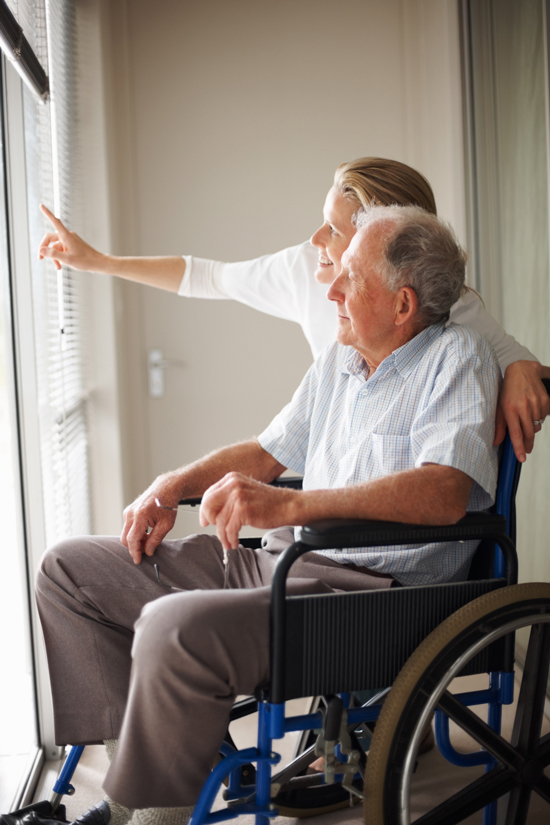Caring for the elderly – how to make your home user friendly
Index
Close to friends and lifestyle – it’s no wonder that many older Australians are choosing to stay put, rather than moving into a retirement village or downsizing to a smaller unit.

Modifying the home allows senior Australians to stay in their homes as they get older. While the future might bring robots and smart home technology, for now proper planning is critical to ensure that risks are minimised.
All houses have some degree of risk inherent in their design. So it’s important to look critically at the home, and identify key places that pose a risk of injury. Consider risks such as slippery bathroom tiles, cluttered rooms, sharp corners or dark stairwells. To make the home safe and accessible, as many risks as possible must be removed, whether it’s for wheelchair access, dementia patients, the frail or infirm.
Entry ways
Is the main access to your home via the front entry? If so, minimise the number of steps leading from the footpath to the front doorway. Ideally, there will be no steps at all, allowing for easy access for wheelchairs and those who struggle climbing steps. But if you do have steps, consider replacing them with a ramp with minimal slope.
Hallways and stairs
Eliminate tripping hazards by removing different levels between internal rooms, or install ramps. Stairs are tricky to manage and are a dangerous fall risk, so consider installing a stair lift. As a minimum, mark out the edges of steps with coloured tape so they are easily visible, and install handrails on both sides of all stairways.
Consider swapping out door knobs, (which are tricky with arthritic fingers) with lever-style handles. Repair any loose carpet that might pose a tripping hazard. Remove all rugs.
Bathrooms
Great bathroom design is essential. It should be a safe and risk-free environment, and everything should be within easy reach – from shavers and soap, to toilet paper and towels.
Ideally, the bathroom will be close to the bedroom, but if it’s not, consider moving the bed to a room closer to the bathroom. This will save long walks to the bathroom at night in a dark house.
If renovating your bathroom with accessibility in mind, a walk-in shower or bathtub is essential.
Lower the bathroom sink to ensure that knees in wheelchairs can tuck underneath easily. Install an elevated toilet, and ensure there are plenty of grab rails – especially near the toilet and shower.
Bathroom remodelling ideas:
- Make sure the hot water system heats the water to a safe temperature to avoid scalding accidents.
- Check that the faucets are clearly marked hot and cold.
- Install a liquid soap dispenser so there’s no need to bend down to retrieve slippery soap.
- Install a shelf to safely store electrical products like shavers and hairdryers well away from the sink.
- Use non-skid strips and decals in slippery areas.
- A handheld shower head is a useful addition to a fixed one.
Bedrooms
Remove excess furniture and reduce clutter to remove the risk of falls – wheel chairs and walking frames need plenty of clear space. In the closet, ensure that clothes are stored at an easy arms reach.
Kitchens
Kitchens and danger go hand in hand. Consider the risks posed by knives, gas stoves, slippery floors and heavy pots and pans, and that’s just for starters. But in order to encourage independent living, make it user-friendly – not just safe.
Consider updating the appliances – an electric can opener, a small bench top oven or a microwave can make preparing a simple meal easier. Provide lots of microwaveable containers to make heating small portions a snap. Store equipment in easy-to-reach locations to minimise the need to bend over or reach up high.
Kitchen remodelling ideas:
- Make sure there is lots of clear space for manoeuvring.
- Have bench tops at a variety of heights.
- Install the stove at a lower height.
- A sink with knee clearance will enable a wheelchair to slide underneath it.
- A raised dishwasher will be easier to access.
- Mount a wall oven and install a microwave at an accessible height.
- Redesign storage space to ensure it is easily accessible.
- Install hand rails and grab bars.
Lighting
Good strong lighting is critical for older eyes and failing eyesight. Fix stairwells and dark hallways with bright indirect lighting – motion activated sensors are a great idea. Make sure that light switches are installed at the top and bottom of stairs. Store an emergency torch in the bedside table. Arthritic hands will find light switches with rocker switches are easier to manage.
Caring for the elderly is a big responsibility, and can be fraught with worry. If you’re planning to make modifications for your home, it’s important to get expert advice. With more than 1200 listings of businesses right around Australia that can help you with Home Health Care Aids & Equipment, Yellow Pages is a great place to start.
